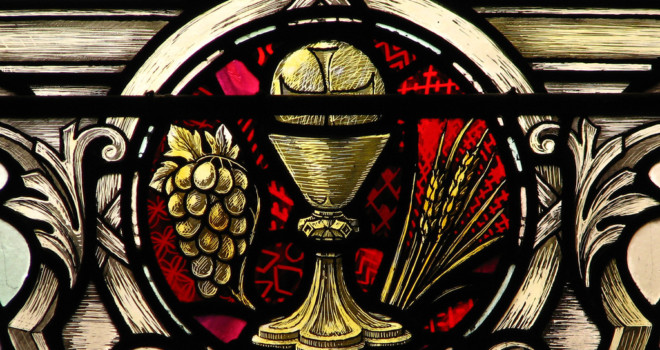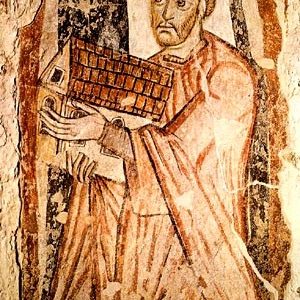This week we will celebrate the great Solemnity of the Most Holy Body and Blood of Christ, colloquially known as the feast of Corpus Christi (“the body of Christ”). On this day we give special thanks for the great gift we celebrate every Mass: the Real Presence of Christ in the Eucharist, one of the most central mysteries of our faith. Of course, the presence of Christ in the Eucharist is also one of the most mysterious mysteries of our faith. Our eyes tell us it is bread and wine before us, but our faith tells us it is the Body and Blood, Soul and Divinity of Jesus Christ. The Church’s Tradition has handed down to us a word to describe this reality: transubstantiation, which says that the accidents of bread and wine remain while the substance becomes that of Christ Himself. For many, though, this term is no help: the technical philosophical explanations are just as head-scratch-inducing as the claim itself. Yet once some of the finer points are made clearer, this explanation can be quite helpful.
First, a bit of background. To borrow a phrase from St. Anselm of Canterbury, our faith is always seeking understanding—fides quarens intellectum—and so we often turn to the tools of understanding, to philosophy, to contemplate the truths of the faith. The Church has found the philosophy of Aristotle in particular to be a fitting partner to the faith, so Aristotelian terms have often been employed in theological investigations. (This can be seen pre-eminently in the work of St. Thomas Aquinas.) The concept of transubstantiation is one such instance of the Church making use of Aristotelian terms: substance and accident. What do these mean?
To put it simply: for Aristotle, there is a real distinction between what a thing is and what a thing is like.
This is a common sense observation, but one that Aristotle builds into his systematic thought about reality. Let’s use for our example a human being. What it is, as we’ve just said, is a human being. The human being will have all kinds of different characteristics—weight, height, hair style—but essentially, before anything else, apart from any other attribute, it is first and foremost a human being. The human being’s weight could fluctuate; his height could increase or decrease with age; his hair style could change from a crewcut to dreadlocks; but those changes do not put that human being out of existence and an entirely new one into being. There is something that endures beyond all these changes: the human being himself, in his essence.
We could put it this way: with all the aspects of a human being and all the ways they can change, there is something that stands under those different attributes. “Stands under” in Latin is sub–stans, which gives us the word substance. All of these changeable, secondary aspects of the substance are, you might say, “attached” to the thing, but are not an integral part of the thing itself. “Attached” in Latin is accidens, which gives us the word accidents. Thus, substance refers to what a thing is, and accidents refer to what a thing is like.
Thinking of things this way, we could say that there are two kinds of change a thing might normally undergo: substantial change and accidental change. In a substantial change, the thing that was ceases to be and a new thing comes to exist, as when a log burns and becomes ashes, or when a lump of dough bakes and becomes bread. Something new has come into being. Substantial changes are virtually always accompanied by accidental changes, because different kinds of things typically have different attributes. The log that was hard and brown becomes fine and black. The dough that was, well, doughy and white becomes soft and golden. Here both what a thing is and what it’s like change. It can also happen that the thing remains but its characteristics change, as when a log is chopped in half and loses mass, or when a lump of dough is sprinkled with sugar and becomes sweet. This is only accidental change.
Once we distinguish the difference between these two, what happens in the mystery of the Eucharist, in transubstantiation, becomes clearer. If it’s possible for the attributes of a thing to change while that thing remains the same, it’s intelligible for the thing itself to change while the attributes remain the same. This is precisely what happens in the Eucharist: the substances of the bread and wine change, but the accidents remain the same. That is, what they are is now different, but what they are like is not. Before the Mass, the bread is small, soft, and white, and the wine is wet, aromatic, and intoxicating. After the words of consecration are prayed, all of these attributes remain, but what is on the altar is no longer bread and wine, but the very substance and presence of Jesus Christ Himself.
This explanation by no means exhausts the mystery of the Eucharist. As with all the sacraments, there is something here beyond our comprehension. But while reason cannot completely encapsulate the Eucharist, reason can at least show that what we claim about the Eucharist is not unreasonable. It is mysterious, but it is not absurd. The doctrine of transubstantiation helps us to understand how the eyes of faith can see what the eyes of the body cannot.












